ViReN
Flashlight Enthusiast
Nyogel 779ZC, Nyogel 759G, Nyogel 760G Lubricants
I got Nyogel 779ZC, Nyogel 759G from www.lighthound.com more than 2 years ago. With this post, I attempt to share my experience with Nyogel lubs. I have also posted simple steps for flashlight care. Hope this helps for some one in need.
General Description:

I got Nyogel 779ZC, Nyogel 759G from www.lighthound.com more than 2 years ago. With this post, I attempt to share my experience with Nyogel lubs. I have also posted simple steps for flashlight care. Hope this helps for some one in need.
General Description:
Nyogel 779ZC, Nyogel 759G and Nyogel 760G are special type of high-quality, synthetic lubricant greases from Nye Lubricants Inc. Nye products are carefully engineered materials, formulated for a specific application marketed under SmartGrease™ brand.
Nyogel 779ZC is relatively thick, higher in viscosity grease that offers a higher level of damping and water protection. NyoGel 779ZC is silica thickened, synthetic hydrocarbon grease intended for mechanical components. It is designed and rated for temperatures from -20°C to 125°C. NyoGel 779ZC contains special additives for reducing wear of metal surfaces. NyoGel 779ZC works well for the flashlight o-rings at the bezel and tailcap as well as on threads on flashlights.
NyoGel 759G is relatively soft, lower in viscosity grease that offers a smoother feeling and lower level of damping. Like 779ZC, Nyogel 759G is also a silica thickened, synthetic hydrocarbon grease. Nyogel 759G is designed for the lubrication and protection of electrical contacts. NyoGel 759G is rated for temperature ranging from -40°C to 125°C.
NyoGel 760G is very similar to 759G. In fact, NyoGel 759G is now replaced by NyoGel 760G. NyoGel 760G offers slightly higher thermal stability and is rated for temperature ranging from -40°C to 135°C. In addition to that, NyoGel 760G has UV dye for inspection and copper passivator is added to it for enhanced corrosion prevention. Like Nyogel 759G, the NyoGel 760G is relatively soft, higher in viscosity grease offering a smoother feeling and lower level of damping. NyoGel 760G is also a synthetic hydrocarbon grease that is designed for the lubrication and protection of electrical contacts.
Note that NyoGel Nyogel 779ZC, Nyogel 759G and Nyogel 760G are not electrically conductive but designed for lubricating surfaces that are conductive. They offer great environmental and corrosion protection and extend the life of components in use.
Lighthound no longer carries NyoGel 759G and at the time of this review, Lighthound offers the latest Nyogel 779ZC and Nyogel 760G. This review is for 25 gram tubes of Nyogel 779ZC and Nyogel 759G that we have been using since as early as July 2006. In this review we share our experience of over 2 years using Nyogel 779ZC and Nyogel 759G lubricants. 25 grams is enough lubrication for hundreds or even thousands of applications. For more than 2+ years we have been using on considerable number of flashlights and yet we have about 25% of supplies still available. Supply for most users may last even longer.
For those who cant wait to read full review, please be advised that these are excellent lubricants and head straight to www.lighthound.com to procure Nyogel 779ZC and Nyogel 760G. NyoGel 779ZC and Nyogel 759G worked extremely well for the flashlight O-rings at the bezel and tailcap as well as on threads. For those who want to know how it performed over the period of 2 years and need to know important information on taking care of flashlights with Nyogel 779ZC, Nyogel 759G (Nyogel 760G) read on....
Pictures:Nyogel 779ZC is relatively thick, higher in viscosity grease that offers a higher level of damping and water protection. NyoGel 779ZC is silica thickened, synthetic hydrocarbon grease intended for mechanical components. It is designed and rated for temperatures from -20°C to 125°C. NyoGel 779ZC contains special additives for reducing wear of metal surfaces. NyoGel 779ZC works well for the flashlight o-rings at the bezel and tailcap as well as on threads on flashlights.
NyoGel 759G is relatively soft, lower in viscosity grease that offers a smoother feeling and lower level of damping. Like 779ZC, Nyogel 759G is also a silica thickened, synthetic hydrocarbon grease. Nyogel 759G is designed for the lubrication and protection of electrical contacts. NyoGel 759G is rated for temperature ranging from -40°C to 125°C.
NyoGel 760G is very similar to 759G. In fact, NyoGel 759G is now replaced by NyoGel 760G. NyoGel 760G offers slightly higher thermal stability and is rated for temperature ranging from -40°C to 135°C. In addition to that, NyoGel 760G has UV dye for inspection and copper passivator is added to it for enhanced corrosion prevention. Like Nyogel 759G, the NyoGel 760G is relatively soft, higher in viscosity grease offering a smoother feeling and lower level of damping. NyoGel 760G is also a synthetic hydrocarbon grease that is designed for the lubrication and protection of electrical contacts.
Note that NyoGel Nyogel 779ZC, Nyogel 759G and Nyogel 760G are not electrically conductive but designed for lubricating surfaces that are conductive. They offer great environmental and corrosion protection and extend the life of components in use.
Lighthound no longer carries NyoGel 759G and at the time of this review, Lighthound offers the latest Nyogel 779ZC and Nyogel 760G. This review is for 25 gram tubes of Nyogel 779ZC and Nyogel 759G that we have been using since as early as July 2006. In this review we share our experience of over 2 years using Nyogel 779ZC and Nyogel 759G lubricants. 25 grams is enough lubrication for hundreds or even thousands of applications. For more than 2+ years we have been using on considerable number of flashlights and yet we have about 25% of supplies still available. Supply for most users may last even longer.
For those who cant wait to read full review, please be advised that these are excellent lubricants and head straight to www.lighthound.com to procure Nyogel 779ZC and Nyogel 760G. NyoGel 779ZC and Nyogel 759G worked extremely well for the flashlight O-rings at the bezel and tailcap as well as on threads. For those who want to know how it performed over the period of 2 years and need to know important information on taking care of flashlights with Nyogel 779ZC, Nyogel 759G (Nyogel 760G) read on....
Nyogel 779ZC & Nyogel 759G: Nothing shiny here. The pictures here show two year old used 25 gm tubes of Nyogel 779ZC & Nyogel 759G.
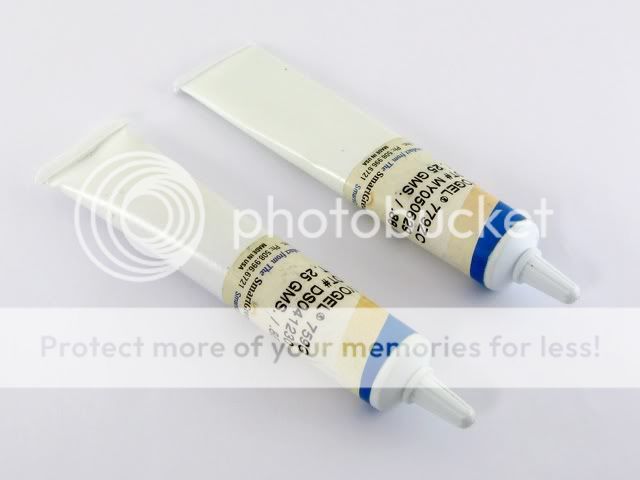
Using Nyogel 779ZC, Nyogel 759G, Nyogel 760G Lubricants for Flashlight Care:
So how do we use Nyogel 779ZC & Nyogel 759G? Which one is best for a typical application? Can we use both together? We attempt to answer these questions here. Normally you can use either of Nyogel 779ZC and Nyogel 759G in any of the flashlights.
For this review, we are taking up an example of Jet I Pro. Steps shown here are for typical application process for tail cap threads. You may however apply same steps for threads on bezel end of battery tube. So now let's have a look at how tail cap threads look after quite a few battery changes. They look dirty, don't they? As you can see, they are very dirty where the battery tube ends. That's because end section has to travel more in to the tailcap switch. Threads inside the tailcap are also equally dirty.
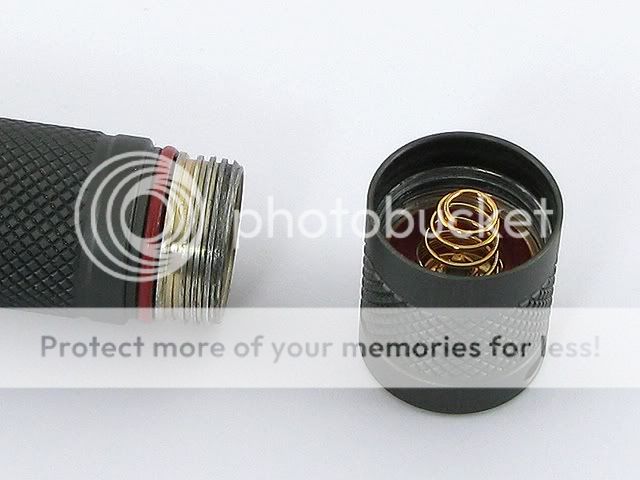
Step 1 - Clean the threads: To clean threads we used simple tissue paper lightly soaked in pure water. Although, you can use any thing as long as it is not abrasive or damaging. Refrain from using strong solvent based cleaning solutions as they might cause damage to tail cap components and O-rings. Before beginning, we suggest you to remove O-ring. Threads on both battery tube as well as tail cap should be thoroughly cleaned. Cleaning tail cap threads is little difficult as compared to battery tube threads. You need to ensure that the negative contact spring does not get dislocated or malformed. Due care should be taken while cleaning tail cap threads. Wipe off the O-Ring with soft tissue soaked in water.
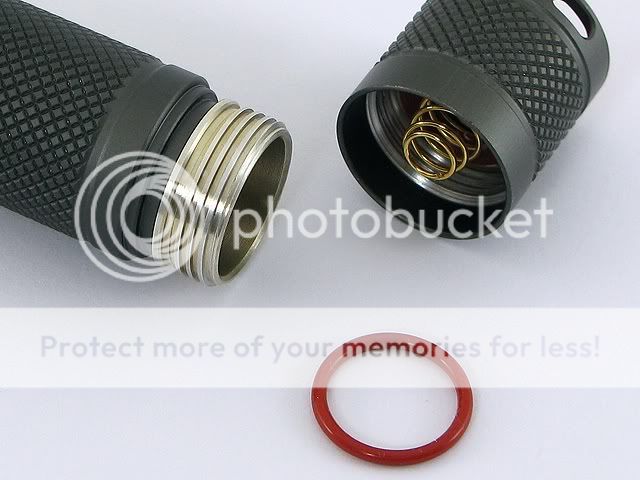
Caution: The threads at times may be sharp and may cause injury during cleaning. Use protective gear while cleaning the threads.
Step 2 - Choosing a right Lubricant: To make things simple, you can use any one of Nyogel 779ZC or Nyogel 759G. But let's give it a little thought. Nyogel 779ZC inheritably is a thicker where as Nyogel 759G is thinner relatively. Thicker lubricant should be used when there is more gap / play between threads. Thinner lubricant should be used for finely machined threads.
Step 3 - Applying the chosen Lubricant: First apply a little amount and spread it with fingers. Put back the tail cap so that the lubricant penetrates the tail cap threads.
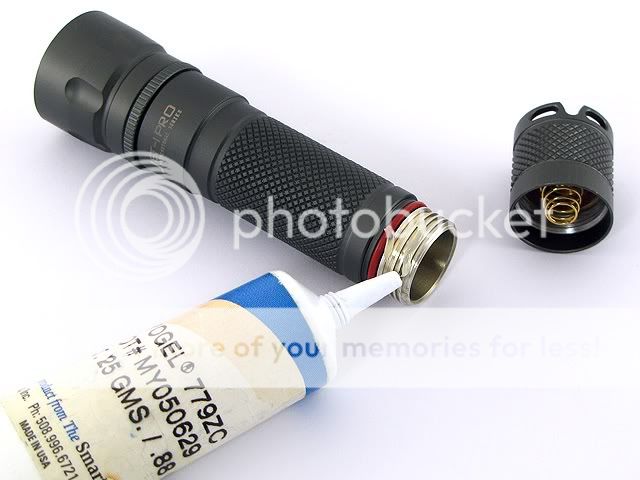
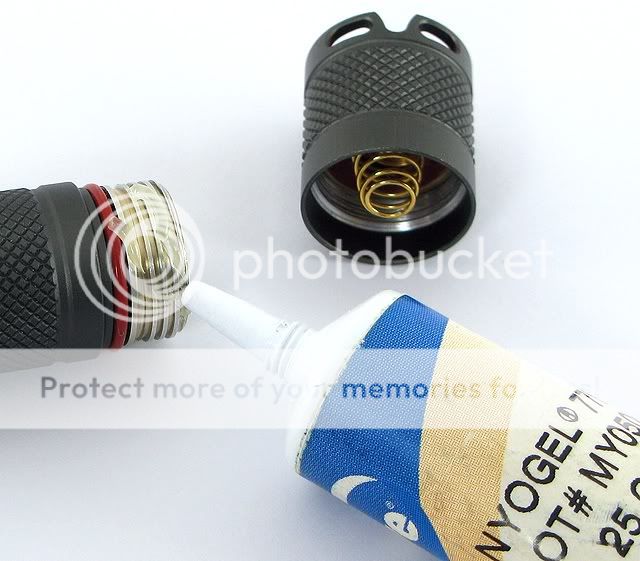
Step 4 - Ensuring even application of Lubricant: With first application, it is likely that all threads are not evenly covered. So next step is to apply even more lubricant so that all threads are covered. Ensure that you are not using way too much that it starts oozing out of threads.
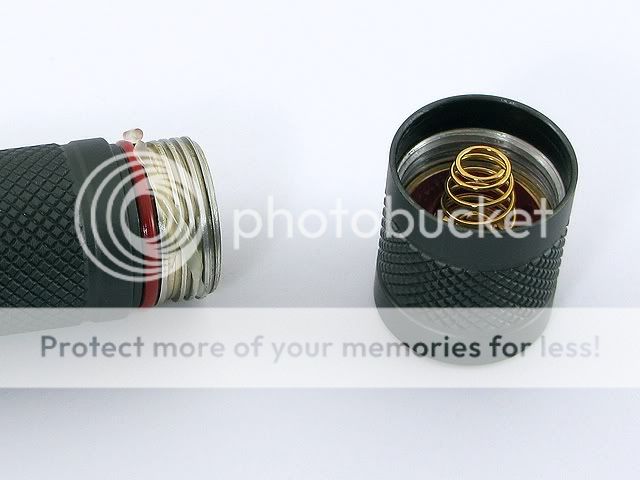
Step 5 - Finally evenly spread lubricant: Here is a closeup of evenly spread NyoGel 779ZC over the threads of both tail cap and battery tube. Notice that the O-ring is also very well lubricated.
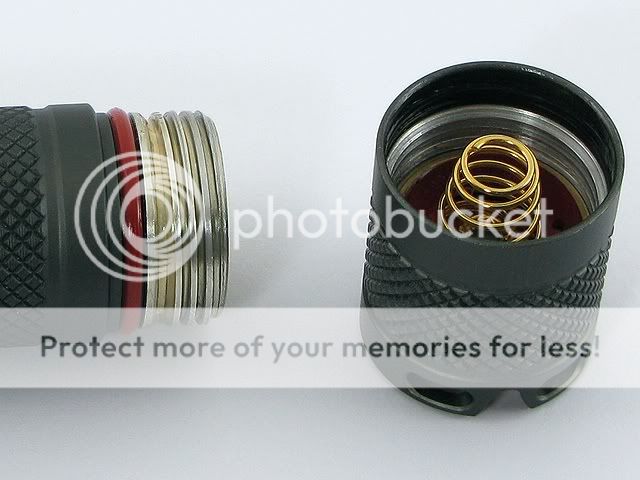
So when do we use the thinner version Nyogel 759G? Let's see an example. This is Zebralight H50 Q5. It has fine pitch threads on battery tube and the tail cap acts as a twist switch. You need to ensure that the operation is smooth and the switching operation does not require much efforts. The relatively thinner version Nyogel 759G is perfectly suited for such an application. Before application, we recommend you to clean the threads as explained above. You need to apply a little amount of Nyogel 759G and it will spread evenly across the threads.
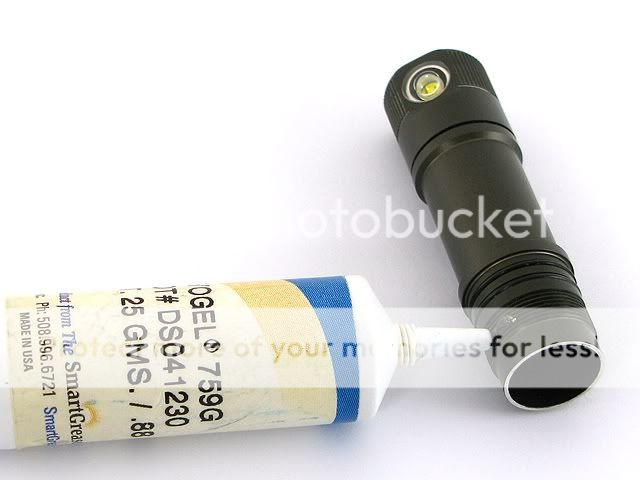
For people who are interested in technical data, please view the complete review.
Hope this helps For this review, we are taking up an example of Jet I Pro. Steps shown here are for typical application process for tail cap threads. You may however apply same steps for threads on bezel end of battery tube. So now let's have a look at how tail cap threads look after quite a few battery changes. They look dirty, don't they? As you can see, they are very dirty where the battery tube ends. That's because end section has to travel more in to the tailcap switch. Threads inside the tailcap are also equally dirty.

Step 1 - Clean the threads: To clean threads we used simple tissue paper lightly soaked in pure water. Although, you can use any thing as long as it is not abrasive or damaging. Refrain from using strong solvent based cleaning solutions as they might cause damage to tail cap components and O-rings. Before beginning, we suggest you to remove O-ring. Threads on both battery tube as well as tail cap should be thoroughly cleaned. Cleaning tail cap threads is little difficult as compared to battery tube threads. You need to ensure that the negative contact spring does not get dislocated or malformed. Due care should be taken while cleaning tail cap threads. Wipe off the O-Ring with soft tissue soaked in water.

Caution: The threads at times may be sharp and may cause injury during cleaning. Use protective gear while cleaning the threads.
Step 2 - Choosing a right Lubricant: To make things simple, you can use any one of Nyogel 779ZC or Nyogel 759G. But let's give it a little thought. Nyogel 779ZC inheritably is a thicker where as Nyogel 759G is thinner relatively. Thicker lubricant should be used when there is more gap / play between threads. Thinner lubricant should be used for finely machined threads.
Step 3 - Applying the chosen Lubricant: First apply a little amount and spread it with fingers. Put back the tail cap so that the lubricant penetrates the tail cap threads.


Step 4 - Ensuring even application of Lubricant: With first application, it is likely that all threads are not evenly covered. So next step is to apply even more lubricant so that all threads are covered. Ensure that you are not using way too much that it starts oozing out of threads.

Step 5 - Finally evenly spread lubricant: Here is a closeup of evenly spread NyoGel 779ZC over the threads of both tail cap and battery tube. Notice that the O-ring is also very well lubricated.

So when do we use the thinner version Nyogel 759G? Let's see an example. This is Zebralight H50 Q5. It has fine pitch threads on battery tube and the tail cap acts as a twist switch. You need to ensure that the operation is smooth and the switching operation does not require much efforts. The relatively thinner version Nyogel 759G is perfectly suited for such an application. Before application, we recommend you to clean the threads as explained above. You need to apply a little amount of Nyogel 759G and it will spread evenly across the threads.

For people who are interested in technical data, please view the complete review.
Last edited:


